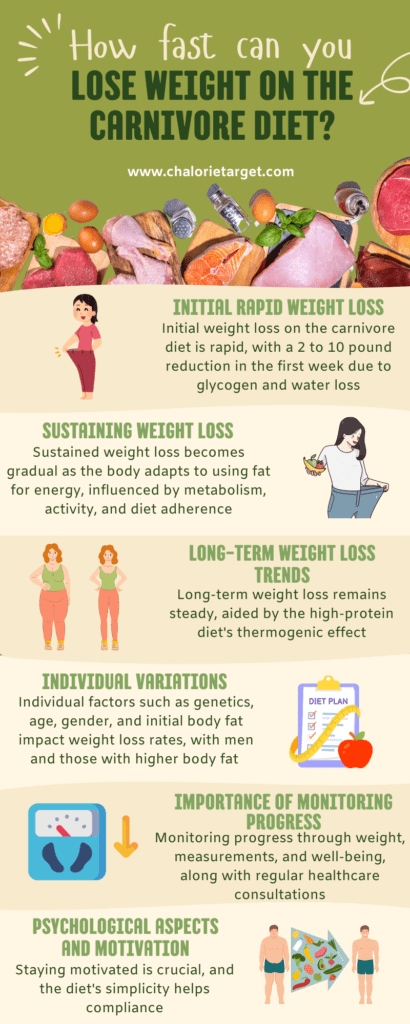1. Introduction to the Carnivore Diet
The carnivore diet is gaining traction among health enthusiasts for its simplicity and purported effectiveness in rapid weight loss. This all-meat diet plan primarily consists of animal products, such as beef, pork, fish, and eggs, excluding almost all plant-based foods.
Its growing popularity stems from its distinct approach to eating and the bold claims of transformative health benefits. But how fast can you approach weight loss goals on the carnivore diet? Let’s delve into the science, benefits and risks.
2. Understanding the Science Behind Rapid Weight Loss
a. The Metabolic Process
The primary mechanism that drives weight loss on the carnivore diet is ketosis. Ketosis is a metabolic state where the body burns fat for fuel instead of carbohydrates. By eliminating carbs, the body is forced to use fat stores for energy, which can accelerate fat loss.
According to a study published in The American Journal of Clinical Nutrition, low-carb diets can significantly increase the rate of fat oxidation.
b. Accelerated Fat Burning
The carnivore diet’s high protein content is crucial in weight loss. Protein has a higher thermic effect than fats and carbohydrates, meaning the body uses more energy to digest and metabolize it.
This process increases overall energy expenditure, thereby aiding weight loss. Additionally, proteins are highly satiating, which can help reduce overall calorie intake by curbing hunger and preventing overeating.
Read More: What is a Carb Consistent Diet?
3. Realistic Expectations
a. Range of Weight Loss Achievable
While the carnivore diet can lead to rapid weight loss, setting realistic expectations is essential. Initial weight loss is often more significant due to water loss when carbohydrate intake is drastically reduced.
According to the National Institutes of Health, individuals can lose 2 to 10 pounds in the first week. Over time, the rate of weight loss will vary based on factors like metabolism, activity level, and adherence to the diet.
b. Importance of Individual Variations
Genetics, age, and starting weight all play crucial roles in quickly losing weight on the carnivore diet. It’s also worth noting that men tend to lose weight faster than women due to higher muscle mass and metabolic rate.
4. Potential Benefits Beyond Weight Loss
a. Improved Energy Levels and Mental Clarity
Many adherents of the carnivore diet report sustained energy levels throughout the day. This can be attributed to the stable blood sugar levels maintained by a low-carb, high-protein diet.
Furthermore, several individuals have noted improved mental clarity and focus, likely due to reduced blood sugar fluctuations familiar with high-carb diets.
b. Overall Health Improvements
Beyond weight loss, the carnivore diet may offer other health benefits, such as:
- Reducing inflammation
- Improving insulin sensitivity
- Enhancing digestive health con
However, these benefits are mainly anecdotal and require further scientific investigation to substantiate.
5. Risks and Considerations
a. Potential Drawbacks and Health Concerns
While the carnivore diet can be effective for weight loss, it’s not without health risks:
- Nutritional Deficiencies: Excluding entire food groups can lead to deficiencies in essential vitamins and minerals, such as fibre, vitamin C, and potassium.
- Kidney Strain: High protein intake can strain the kidneys, particularly in individuals with pre-existing kidney conditions.
- Cholesterol Levels: Consuming large amounts of red meat can increase cholesterol levels, raising cardiovascular risks.
b. Need for Regular Medical Check-ups
Given these risks, regular medical check-ups are crucial for those on the carnivore diet. Before starting the diet, consulting with a healthcare professional can help mitigate potential adverse effects.
Read More: How to Stay Consistent with Working Out and Diet
6. Getting Started
a. Practical Tips for Those Considering the Carnivore Diet
For those contemplating the carnivore diet, here are some practical tips to help you get started:
- Meal Planning: To ensure a range of nutrients, focus on a variety of animal products, including different types of meat, fish, and eggs.
- Stay Hydrated: Drink plenty of water to support metabolic processes and kidney function.
- Gradual Transition: Consider easing into the diet by gradually reducing carb intake to allow your body to adjust.
b. Substitution Options
If sticking solely to animal products seems daunting, consider initially integrating small amounts of low-carb vegetables. This can help ease the transition and provide additional nutrients.
7.

Elaborating on the speed of weight loss on the carnivore diet involves examining various factors that contribute to this process.
a. Initial Rapid Weight Loss
Generally, individuals experience a noticeable drop in weight within the first week of starting the carnivore diet. This early weight loss is primarily driven by the body’s reduction in glycogen stores, which deplete when carbohydrate intake is minimized.
Since glycogen binds with water within the muscles, its depletion significantly reduces water weight. According to the National Institutes of Health, this can translate into a weight loss of 2 to 10 pounds in the first week alone (2).
b. Sustaining Weight Loss
After the initial phase, the body adjusts to using fats as its primary energy source. During this stage, weight loss may become more gradual. The rate at which fat loss occurs is influenced by individual factors such as metabolism, physical activity intensity, and strict diet adherence.
c. Long-Term Weight Loss Trends
For many, continuing a high-protein, low-carb diet helps maintain a steady pace of fat loss. This trend can be attributed to the dietary thermogenic effect, where protein digestion requires more energy, and the macronutrient’s satiating nature reduces overall calorie consumption.
d. Individual Variations
It’s important to acknowledge that weight loss on the carnivore diet is not a one-size-fits-all scenario. Genetics, age, gender, and starting weight can significantly impact the rate of weight loss.
Men, in particular, may see faster results due to higher muscle mass and metabolic rates than women. Additionally, those with higher initial body fat percentages might initially experience quicker weight loss than those who start with less body fat.
e. Importance of Monitoring Progress
Monitoring progress and making necessary adjustments are crucial to maximizing weight loss while ensuring health. Recording weight changes, body measurements, and how one feels physically and mentally can provide valuable insights. Regular check-ins with a healthcare professional can help address any concerns, adjust dietary choices, and meet nutritional needs.
f. Psychological Aspects and Motivation
Staying motivated throughout the weight loss journey is pivotal. The carnivore diet’s simplicity can aid in compliance, as it eliminates the need to constantly track macronutrients or calorie intake.
However, having a solid support system, whether it’s through social media groups, friends, or family, can provide encouragement and accountability.
8. How long is the carnivore diet safe to do?
Determining the long-term safety of following the carnivore diet involves considering health factors and individual responses. Advocates claim it can be maintained indefinitely if well-planned and monitored, with benefits like weight stabilization, reduced inflammation, and improved insulin sensitivity.
However, excluding entire food groups risks nutritional deficiencies in vitamins, minerals, and fibre, which are crucial for overall health. High protein intake could strain the kidneys, especially those with pre-existing conditions, and affect cholesterol levels.
Therefore, while some may see benefits, it’s critical to approach the diet cautiously, include regular medical check-ups, and possibly add low-carb vegetables or supplements to mitigate deficiencies.
Individual variations like genetic makeup, age, and metabolic rate also affect the diet’s viability. Continuous monitoring through self-assessment and professional advice is essential to ensure safety and efficacy while gaining the potential benefits of the carnivore diet.
9. Carnivore Recipes
Here are five recipes to help you get started on the carnivore diet:
a. Recipe 1: Grilled Ribeye Steak
i. Ingredients:
- 1 ribeye steak, about 1 inch thick
- Salt, to taste
- Black pepper, to taste (optional)
- Butter, for serving
ii. Instructions:
- Preheat your grill to high heat.
- Season the ribeye steak generously with salt and black pepper (if using).
- Place the steak on the grill and cook for 4-5 minutes on each side until it reaches your desired level.
- Remove from the grill and let it rest for a few minutes.
- Serve with a dollop of butter on top.
b. Recipe 2: Carnivore Breakfast Bacon and Eggs
i. Ingredients:
- 4 strips of bacon
- 3 large eggs
- Salt, to taste
ii. Instructions:
- In a large skillet, cook the bacon over medium heat until crispy.
- Remove the bacon and set it aside, leaving the bacon grease in the skillet.
- Crack the eggs into the skillet and cook sunny-side-up or scrambled, according to your preference.
- Season with salt and serve with the crispy bacon on the side.
c. Recipe 3: Roasted Bone Marrow
i. Ingredients:
- 3-4 marrow bones
- Sea salt, to taste
- Fresh herbs for garnish (optional)
ii. Instructions:
- Preheat the oven to 450°F (232°C).
- Arrange the marrow bones on a baking sheet.
- Roast in the oven for 15-20 minutes until the marrow is soft and jelly-like.
- Remove from the oven and sprinkle with sea salt and fresh herbs if desired.
- Serve warm with a spoon to scoop out the marrow.
d. Recipe 4: Pan-Seared Lamb Chops
i. Ingredients:
- 4 lamb chops
- Salt, to taste
- Black pepper, to taste (optional)
- 2 tablespoons of ghee or butter
ii. Instructions:
- Season the lamb chops with salt and black pepper (if using).
- Heat the ghee or butter in a skillet over medium-high heat.
- Sear the lamb chops for about 4 minutes on each side or until they reach your desired doneness.
- Remove from the skillet and let them rest for a few minutes before serving.
e. Recipe 5: Beef Liver Pâté
i. Ingredients:
- 1 pound beef liver, cleaned and chopped
- 1 small onion, finely chopped
- 2 cloves garlic, minced
- 1/2 cup heavy cream
- 4 tablespoons butter
- Salt, to taste
ii. Instructions:
- In a skillet, melt 2 tablespoons of butter over medium heat.
- Add the onion and garlic, cooking until translucent.
- Add the chopped liver and cook until no longer pink.
- Pour in the heavy cream and cook until the liquid has mostly evaporated.
- Transfer the mixture to a food processor and blend until smooth, adding the remaining butter and seasoning with salt to taste.
- Chill in the refrigerator before serving.
10. Conclusion
The carnivore diet offers a unique and potentially effective approach to weight loss goals by leveraging ketosis and the thermic effect of protein. While individuals can experience rapid weight loss, setting realistic expectations and considering individual variations is essential.
The diet may offer benefits beyond weight loss, including improved energy levels and mental clarity. However, it’s crucial to be aware of the potential risks and ensure regular medical supervision.
